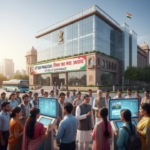
A New Dawn: India’s Vision for Sustainable Growth and Democracy
- admin
- October 21, 2025
- Capital Journal
- 0 Comments
Balancing Economic Progress with Environmental Stewardship and Democratic Principles
Key Metrics:
- Renewable Energy Capacity: India has achieved an installed renewable energy capacity of 175 GW, comprising 100 GW of solar power and 75 GW of wind energy.
- Sustainable Development Goals (SDGs): India’s performance on the SDG Index improved from a score of 60 in 2019-20 to 70 in 2023-24, signaling progress in sustainable development.
- Forest Cover: Forest and tree cover now constitutes 24.56% of India’s total geographical area, reflecting significant conservation efforts.
- Electric Vehicle (EV) Growth: More than 1 million electric vehicles are registered in India, supported by policies aimed at reducing emissions and promoting clean transportation.
News Body
India stands at a transformative juncture, where sustainable development is a cornerstone of its economic and democratic journey. By prioritizing renewable energy, environmental conservation, and inclusive growth, the nation is creating a blueprint for progress that benefits both present and future generations.
Harnessing Renewable Energy
India has emerged as a global leader in renewable energy, achieving a total installed capacity of 175 GW, with 100 GW coming from solar and 75 GW from wind. These initiatives not only reduce the country’s carbon footprint but also ensure energy security and affordability for its growing population. Renewable energy projects like the Solar Park Scheme and the National Wind-Solar Hybrid Policy have paved the way for widespread adoption of clean energy solutions.
Progress Towards Sustainable Development Goals
India has made significant strides in meeting the United Nations’ Sustainable Development Goals. The SDG India Index, developed by NITI Aayog, highlights improvements in areas such as clean energy, education, and health. The nation’s composite score rose from 60 in 2019-20 to 70 in 2023-24, underscoring efforts to balance economic growth with environmental and social well-being.
Protecting Forests and Biodiversity
With forest and tree cover now encompassing 24.56% of its total geographical area, India has demonstrated a strong commitment to afforestation and biodiversity conservation. Programs such as the Green India Mission and the National Afforestation Programme are central to enhancing carbon sequestration and restoring ecosystems. These efforts contribute significantly to mitigating climate change and preserving wildlife habitats.
Advancing Sustainable Transportation
The shift towards sustainable transportation is evident in the increasing adoption of electric vehicles, with over 1 million EVs registered nationwide. Policies like the Faster Adoption and Manufacturing of Hybrid and Electric Vehicles (FAME) scheme have accelerated this transition. By reducing urban air pollution and reliance on fossil fuels, India is aligning its transportation sector with global sustainability goals.
Challenges and Opportunities Ahead
Despite remarkable achievements, India faces challenges in managing rapid urbanization, pollution, and waste disposal. Addressing these issues requires enhancing policy frameworks, investing in green technologies, and promoting community involvement. Expanding public awareness about sustainability and integrating environmental education into mainstream discourse are also crucial for long-term success.
Conclusion
India’s vision for sustainable growth reflects a deep commitment to harmonizing economic progress with environmental care and democratic values. As the nation continues to evolve, it stands as an example of how inclusive development can drive meaningful change while safeguarding natural resources.
By fostering innovation, protecting ecosystems, and empowering communities, India is not just pursuing sustainability—it is shaping a legacy of responsible growth for the world to emulate.



